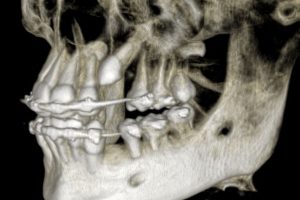I had a great experience, the staff are super nice and very informative. They made sure i was fine and asked if i had any questions, the surgery itself went perfectly smooth. I would recommend them to anyone needing oral surgery. Definitely had a positive experience.
General Information
Impacted Canines
 The maxillary canine (eyetooth) is the second most common tooth to become impacted. The canine tooth is critical in the dental arch and plays an important role in your “bite”. The canine teeth are very strong biting teeth and have the longest roots of any human teeth. They are designed to be the first teeth that touch when your jaws close together so they guide the rest of the teeth into a proper bite. Impacted teeth may cause problems including bone loss, root resorption, and formation of cysts or tumors.
The maxillary canine (eyetooth) is the second most common tooth to become impacted. The canine tooth is critical in the dental arch and plays an important role in your “bite”. The canine teeth are very strong biting teeth and have the longest roots of any human teeth. They are designed to be the first teeth that touch when your jaws close together so they guide the rest of the teeth into a proper bite. Impacted teeth may cause problems including bone loss, root resorption, and formation of cysts or tumors.
Normally, the maxillary canine teeth are the last of the “front” teeth to erupt into place. They usually come into place around the age of 11 and will help to close any space left between the upper front teeth. If a canine gets impacted, every effort is made to get it to erupt into its proper position in the dental arch. The same techniques involved to aid in the eruption can also be applied to any impacted tooth in the upper or lower jaw.
An impacted tooth is less likely to erupt on its own (naturally) as a patient gets older. This is true, even if space is available in the dental arch to fit the impacted tooth. Therefore, it is best to seek the care of an orthodontist that will coordinate treatment with the surgeon. In some cases, the tooth will not budge despite all the efforts of the orthodontist and oral surgeon. Unfortunately, the only option at this point is to extract the impacted tooth and consider an alternate treatment to replace it in the dental arch (crown on a dental implant or a fixed bridge).
Treatment of Impacted Canines
Usually the best mode of treatment to get an impacted tooth into the dental arch is a coordinated treatment to get an impacted tooth into the dental arch is a coordinated treatment plan between your Orthodontist and Oral and Maxillofacial Surgeon. Your orthodontist will typically place braces to open space to allow for proper eruption of the impacted tooth. Once the proper spacing is created, your orthodontist will refer you to the oral surgeon to perform a procedure known as canine exposure. Your oral surgeon may have to extract any retained baby teeth, extra teeth (supernumerary), and/or selected adult teeth that are blocking the eruption of the important canine tooth.
Exposure of Impacted Canines
This simple procedure is generally performed in-office under a general anesthetic. The gum on the impacted tooth is lifted up to expose the hidden tooth underneath. If there is a baby tooth present it will be removed at the same time. Once the tooth is exposed your doctor will bond an orthodontic archwire to the exposed tooth. The bracket will have a gold chain attached to it. The chain is then guided back to the orthodontic archwire where it will be temporarily attached. Sometimes the exposed impacted tooth is left completely uncovered by suturing the gum up high above the tooth or making a window in the gum covering the tooth (on selected cases). Most often the gum will be returned to its original location and sutured back with only the chain remaining visible as it exits a small hole in the gum. Your doctor will provide more details related to your individual treatment plan during the consultation.
Shortly after surgery (1-14 days) the patient will return to the orthodontist. A rubber band will be attached to the chain to put a light eruptive pulling force on the impacted tooth. This will begin the process of moving the tooth into the proper position in the dental arch. This is a carefully controlled, slow process that may take up to a full year to complete. Once the tooth is moved into the arch, the gum around it will be evaluated to make sure it is sufficiently strong and healthy to last for a lifetime of chewing and tooth brushing,
